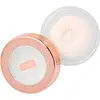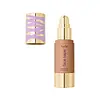What's inside
What's inside
 Key Ingredients
Key Ingredients

 Benefits
Benefits

 Concerns
Concerns

 Ingredients Side-by-side
Ingredients Side-by-side

Cyclopentasiloxane
EmollientDimethicone
EmollientDimethicone/Vinyl Dimethicone Crosspolymer
Skin ConditioningHydrogenated Vegetable Oil
EmollientPentaerythrityl Tetraisostearate
EmollientVinyl Dimethicone/Methicone Silsesquioxane Crosspolymer
Mica
Cosmetic ColorantDisteardimonium Hectorite
StabilisingPEG-10 Dimethicone
Skin ConditioningPPG-25-Laureth-25
EmulsifyingSilica Dimethyl Silylate
EmollientSilica
AbrasiveWater
Skin ConditioningTocopheryl Acetate
AntioxidantParfum
MaskingTrimethylsiloxysilicate
EmollientDiethylhexyl Syringylidenemalonate
Skin ProtectingAscorbyl Palmitate
AntioxidantPropylene Glycol
HumectantCaprylic/Capric Triglyceride
MaskingSodium Cocoyl Alaninate
Butylene Glycol
HumectantGlyceryl Stearate
EmollientCitric Acid
BufferingHydrolyzed Collagen
EmollientTriethoxycaprylylsilane
Hydrolyzed Elastin
EmollientCetyl Hydroxyethylcellulose
Emulsion StabilisingRutin
AntioxidantPalmitoyl Tetrapeptide-7
Skin ConditioningPalmitoyl Tripeptide-1
Skin ConditioningPhaseolus Lunatus Seed Extract
EmollientPhenoxyethanol
PreservativeLimonene
PerfumingLinalool
PerfumingCitral
PerfumingHexyl Cinnamal
PerfumingHydroxycitronellal
PerfumingCI 77891
Cosmetic ColorantCI 75470
Cosmetic ColorantCyclopentasiloxane, Dimethicone, Dimethicone/Vinyl Dimethicone Crosspolymer, Hydrogenated Vegetable Oil, Pentaerythrityl Tetraisostearate, Vinyl Dimethicone/Methicone Silsesquioxane Crosspolymer, Mica, Disteardimonium Hectorite, PEG-10 Dimethicone, PPG-25-Laureth-25, Silica Dimethyl Silylate, Silica, Water, Tocopheryl Acetate, Parfum, Trimethylsiloxysilicate, Diethylhexyl Syringylidenemalonate, Ascorbyl Palmitate, Propylene Glycol, Caprylic/Capric Triglyceride, Sodium Cocoyl Alaninate, Butylene Glycol, Glyceryl Stearate, Citric Acid, Hydrolyzed Collagen, Triethoxycaprylylsilane, Hydrolyzed Elastin, Cetyl Hydroxyethylcellulose, Rutin, Palmitoyl Tetrapeptide-7, Palmitoyl Tripeptide-1, Phaseolus Lunatus Seed Extract, Phenoxyethanol, Limonene, Linalool, Citral, Hexyl Cinnamal, Hydroxycitronellal, CI 77891, CI 75470
Water
Skin ConditioningCyclopentasiloxane
EmollientMethyl Methacrylate Crosspolymer
Phenyl Trimethicone
Skin ConditioningButylene Glycol
HumectantCyclohexasiloxane
EmollientCaprylyl Methicone
Skin ConditioningGlycerin
HumectantPEG-10 Dimethicone
Skin ConditioningTrimethylsiloxysilicate
EmollientCyclomethicone
EmollientSorbitan Isostearate
EmulsifyingSodium Chloride
MaskingCetyl PEG/PPG-10/1 Dimethicone
EmulsifyingTriethyl Citrate
MaskingDisteardimonium Hectorite
StabilisingAluminum Hydroxide
EmollientPhenoxyethanol
PreservativeDimethicone Crosspolymer
Emulsion StabilisingTriethoxycaprylylsilane
Parfum
MaskingEthylhexylglycerin
Skin ConditioningDisodium EDTA
Benzyl Salicylate
PerfumingHexyl Cinnamal
PerfumingLimonene
PerfumingHydroxycitronellal
PerfumingGeraniol
PerfumingAmyl Cinnamal
PerfumingLinalool
PerfumingPyrus Malus Fruit Extract
Skin Conditioning1,2-Hexanediol
Skin ConditioningTremella Fuciformis Extract
HumectantHyaluronic Acid
HumectantHydrolyzed Hyaluronic Acid
HumectantSodium Hyaluronate
HumectantIron Oxides
CI 77891
Cosmetic ColorantWater, Cyclopentasiloxane, Methyl Methacrylate Crosspolymer, Phenyl Trimethicone, Butylene Glycol, Cyclohexasiloxane, Caprylyl Methicone, Glycerin, PEG-10 Dimethicone, Trimethylsiloxysilicate, Cyclomethicone, Sorbitan Isostearate, Sodium Chloride, Cetyl PEG/PPG-10/1 Dimethicone, Triethyl Citrate, Disteardimonium Hectorite, Aluminum Hydroxide, Phenoxyethanol, Dimethicone Crosspolymer, Triethoxycaprylylsilane, Parfum, Ethylhexylglycerin, Disodium EDTA, Benzyl Salicylate, Hexyl Cinnamal, Limonene, Hydroxycitronellal, Geraniol, Amyl Cinnamal, Linalool, Pyrus Malus Fruit Extract, 1,2-Hexanediol, Tremella Fuciformis Extract, Hyaluronic Acid, Hydrolyzed Hyaluronic Acid, Sodium Hyaluronate, Iron Oxides, CI 77891
Ingredients Explained
These ingredients are found in both products.
Ingredients higher up in an ingredient list are typically present in a larger amount.
Butylene Glycol (or BG) is used within cosmetic products for a few different reasons:
Overall, Butylene Glycol is a safe and well-rounded ingredient that works well with other ingredients.
Though this ingredient works well with most skin types, some people with sensitive skin may experience a reaction such as allergic rashes, closed comedones, or itchiness.
Learn more about Butylene GlycolCi 77891 is a white pigment from Titanium dioxide. It is naturally found in minerals such as rutile and ilmenite.
It's main function is to add a white color to cosmetics. It can also be mixed with other colors to create different shades.
Ci 77891 is commonly found in sunscreens due to its ability to block UV rays.
Learn more about CI 77891Cyclopentasiloxane, or D5, is a silicone used to improve texture of products and trap moisture.
D5 is considered lightweight and volatile. Volatile means it evaporates quickly after application. Once evaporated, D5 leaves a thin barrier that helps keep skin hydrated.
It is also an emollient. Emollients help soften the skin and prevent water loss. Silicones create a silky texture in products. D5 helps other ingredients become more spreadable.
Studies show D5 is safe to use in skincare products. We recommend speaking with a skincare professional if you have concerns.
Learn more about CyclopentasiloxaneDisteardimonium Hectorite comes from the clay mineral named hectorite. It is used to add thickness to a product.
It can also help stabilize a product by helping to disperse other ingredients.
Hectorite is a rare, white clay mineral.
Learn more about Disteardimonium HectoriteHexyl Cinnamal is a fragrance ingredient with a similar scent to jasmine. It can be naturally found in chamomile essential oil.
This ingredient is a known EU allergen and may sensitize the skin. The EU requires this ingredient to be listed separately on an ingredients list.
Hexyl Cinnamal is not water soluble but is soluble in oils.
Learn more about Hexyl CinnamalHydroxycitronellal is a fragrance created from citronellal. The smell of hydroxycitronellal is often described as "citrus-like" or "melon-like".
Hydroxycitronellal is a known EU allergen and may cause irritation when applied to the skin.
Limonene is a fragrance that adds scent and taste to a formulation.
It's found in the peel oil of citrus fruits and other plants such as lavender and eucalyptus. The scent of limonene is generally described as "sweet citrus".
Limonene acts as an antioxidant, meaning it helps neutralize free radicals.
When exposed to air, oxidized limonene may sensitize the skin. Because of this, limonene is often avoided by people with sensitive skin.
The term 'fragrance' is not regulated in many countries. In many cases, it is up to the brand to define this term. For instance, many brands choose to label themselves as "fragrance-free" because they are not using synthetic fragrances. However, their products may still contain ingredients such as essential oils that are considered a fragrance.
Learn more about LimoneneLinalool is a fragrance and helps add scent to products. It's derived from common plants such as cinnamon, mint, citrus, and lavender.
Like Limonene, this ingredient oxidizes when exposed to air. Oxidized linalool can cause allergies and skin sensitivity.
This ingredient has a scent that is floral, spicy tropical, and citrus-like.
Learn more about LinaloolParfum is a catch-all term for an ingredient or more that is used to give a scent to products.
Also called "fragrance", this ingredient can be a blend of hundreds of chemicals or plant oils. This means every product with "fragrance" or "parfum" in the ingredients list is a different mixture.
For instance, Habanolide is a proprietary trade name for a specific aroma chemical. When used as a fragrance ingredient in cosmetics, most aroma chemicals fall under the broad labeling category of “FRAGRANCE” or “PARFUM” according to EU and US regulations.
The term 'parfum' or 'fragrance' is not regulated in many countries. In many cases, it is up to the brand to define this term.
For instance, many brands choose to label themselves as "fragrance-free" because they are not using synthetic fragrances. However, their products may still contain ingredients such as essential oils that are considered a fragrance by INCI standards.
One example is Calendula flower extract. Calendula is an essential oil that still imparts a scent or 'fragrance'.
Depending on the blend, the ingredients in the mixture can cause allergies and sensitivities on the skin. Some ingredients that are known EU allergens include linalool and citronellol.
Parfum can also be used to mask or cover an unpleasant scent.
The bottom line is: not all fragrances/parfum/ingredients are created equally. If you are worried about fragrances, we recommend taking a closer look at an ingredient. And of course, we always recommend speaking with a professional.
Learn more about ParfumPeg-10 Dimethicone is silicone with conditioner and emulsifier properties. It mostly acts as an emollient in skincare and and humectant in haircare.
According to the manufacturer, acidic formulations decrease the stability of this ingredient. It works best in neutral or near neutral formulations.
Phenoxyethanol is a preservative that has germicide, antimicrobial, and aromatic properties. Studies show that phenoxyethanol can prevent microbial growth. By itself, it has a scent that is similar to that of a rose.
It's often used in formulations along with Caprylyl Glycol to preserve the shelf life of products.
Triethoxycaprylylsilane is a silicone used to bind and stabilize ingredients.
As an emulsifier, it helps prevent ingredients from separating. This can help elongate the shelf life of products.
Triethoxycaprylylsilane is often used to coat mineral sunscreens ingredients to help give a better feel. It also helps reduce oxidative stress in sunscreens.
Learn more about TriethoxycaprylylsilaneThis silicone is an emollient. Emollients create a thin film on the skin to prevent moisture from escaping.
It is not soluble in water and helps increase water-resistance in products.
According to a manufacturer, it can blend seamlessly with silicone oils, such as Cyclopentasiloxane.
Learn more about TrimethylsiloxysilicateWater. It's the most common cosmetic ingredient of all. You'll usually see it at the top of ingredient lists, meaning that it makes up the largest part of the product.
So why is it so popular? Water most often acts as a solvent - this means that it helps dissolve other ingredients into the formulation.
You'll also recognize water as that liquid we all need to stay alive. If you see this, drink a glass of water. Stay hydrated!
Learn more about Water